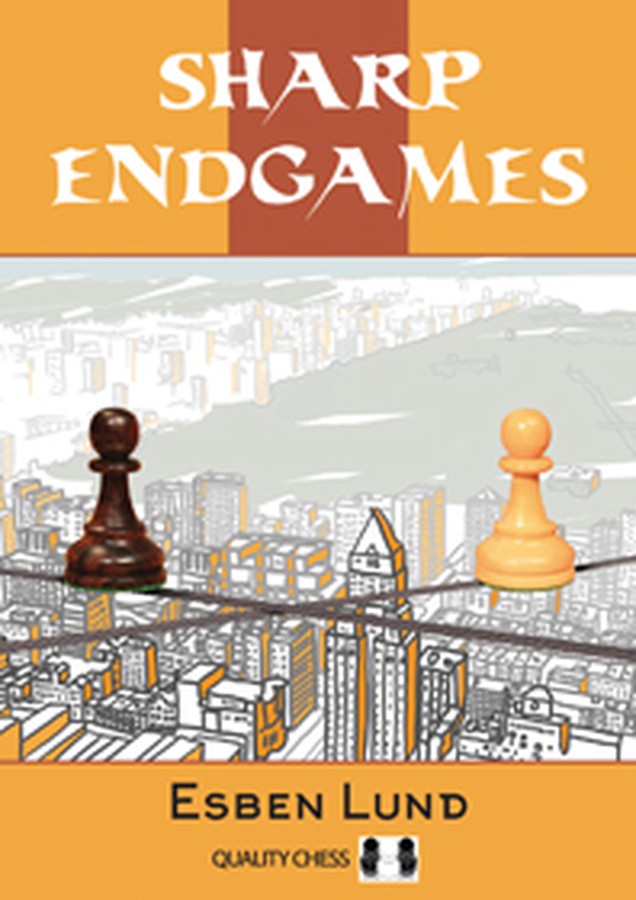| Nivå | C-D |
| Utgivelsesdato | November 2017 |
| Forfatter | |
| Pris | 295 NOK |
Sharp Endgames
En relativt avansert treningsbok i sluttspill. De fleste er sortert i kapitler etter materiell på brettet og kan sies å være både tekniske og taktiske. Mye av boka er treningsoppgaver med foreslått tidsbruk og bred gjennomgang av løsningen.
En imponerende bok, og mest for spillere med ratingnivå cirka 16-1700 og oppover, ja helt opp til stormesterstyrke.
Forlagets egen omtale
Endgames often give rise to the most difficult and pivotal moments of a chess game. In Sharp Endgames, International Master Esben Lund tackles this crucial topic in a unique and innovative way, focusing on the 16 Parameters involved in this type of decision-making.
The book contains more than a hundred carefully chosen exercises, with solutions linked to the 16 Parameters. The feedback is concrete and gives the player a clear way to improve his or her understanding and skill. The exercises can be played out against a partner or engine; the book even contains a step-by-step guide explaining how to configure a chess engine for this purpose.
Esben Lund has issued you a challenge: invest time and effort in this book, and your chess results are going to improve – no matter your current level. The question is: are you ready to accept the challenge? I strongly encourage you to accept – you will not regret it.
From the Foreword by GM Lars Bo HansenEsben Lund, an International Master from Denmark, is a respected author and coach. His two first books for Quality Chess, Rook vs. Two Minor Pieces and The Secret Life of Bad Bishops, were both well received for their originality and absorbing study material.
Fra forordet til stormester Lars Bo Hansen
You hold in your hands a remarkable book – one that has the potential to greatly improve your results on the chess board. The legendary Viktor Korchnoi boldly claimed that anyone who
worked through his book on Practical Rook Endings would be guaranteed to gain at least 100
rating points. Silas Esben Lund, originally from low-key Denmark like myself, is too modest to make such a claim, so let me do it for him: if you work through this book cover to cover, you are going to gain at least a similar amount of rating points as from Korchnoi’s book – very likely more.But be warned: the emphasis here is on work. What you put in, you will get out – don’t expect a quick fix. This is a book for the ambitious chess players who are willing to put in the effort to pursue results through hard work and deliberate practice. The main value of this book is in the depth of the examples and exercises, which are designed to challenge even International Masters and Grandmasters. After trying in vain to solve some of the demanding exercises, I can testify to the difficulty of the challenge!
However, Lund has a knack for making the difficult understandable. His explanations of the
process by which even the most difficult exercises should be (and have been) solved is to the point and highly instructive. He explains how you can sharpen your skills in calculation; shows how to identify the Critical Moments in the game; and highlights how the middlegame is connected to sharp and basic endgames in a logical thread. In doing so, Lund helps his readers improve not only his or her skills in sharp endgames, but also in the middlegame and technical endgames. At the core, the emphasis is on making good decisions at critical stages of the game. For that you need to combine several aspects – calculation, intuition, creativity, basic knowledge of chess, just to name a few. And you have to weave these components together into a useful and practical
process. This is not easy, as many players tend to be biased in one way or another when making decisions in chess.When trying to solve some of the exercises, I was reminded of an episode from a training session the Danish National Team had in Copenhagen with the legendary Russian coach Mark Dvoretsky, shortly before the 2000 Olympiad in Istanbul. Dvoretsky was feeding us difficult exercises,
similar to those of Lund in this book, and one of them was a deceptively simple rook endgame where Black needed to decide where to go with his king in reply to a check. Using intuition and drawing on my long-term interest and experience in rook endgames, I quickly settled on the
right move, but Dvoretsky was not happy with my intuitive decision. He wanted me to calculate and show the line that led to the right decision. While I got it right in this particular instance, Dvoretsky reasoned that being overly reliant on intuition – as opposed to calculation – was a
dangerous bias at Critical Moments. Certainly not all Critical Moments can be solved by intuition only. I took the advice to heart and forced myself to calculate deeper at Critical Moments. Shortly thereafter I had an excellent result at the Olympiad, and a year and a half later I reached a new personal best FIDE rating, despite being semi-retired at the time. This book has the potential to do the same for readers who choose to put in the effort – it will improve your ability to make the right decisions at the Critical Moments late in the game.Out of the many great examples and exercises in this book, I will single out the study by Troitzky (1925) that opens Chapter 2. Unfamiliar to me, this study epitomizes how good decisions draw on a combination of calculation, intuition, creativity, and knowledge of basic endgames. A delight for chess fans interested in both studies and practical play!
I have known Silas for many years from the chess circuit in our shared home country, and I have always liked Silas’s approach to chess, and chess coaching and writing in particular. Silas is an
independent thinker who weaves plenty of personal experiences and games into his coaching and writing. And he shares a very important trait with other excellent coaches – he actually has a well- considered coaching philosophy.His book is extensively researched – not just in terms of the chess content, but also how expertise is achieved – and all the examples have been thoroughly checked by analysis engines and tested on chess students of various strength. As a result, this book is more than just a book – it is a curriculum for how to improve your chess.
Silas likes to take on topics that are under-represented in chess literature. I thoroughly enjoyed his earlier books, which are filled with new concepts that you will find in few other chess books.
| Innbundet? | Nei |
| Type | Bok |
| Språk | Engelsk |
| Antall sider | 304 |

